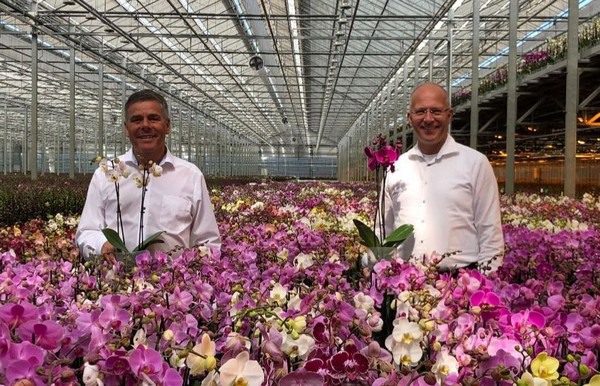Offering phalaenopsis growers increased flexibility. That was the aim when setting up a study into whether Phalaenopsis can flourish on a cultivation floor. Is the cultivation floor comparable with, or even better than, traditional trolley systems? During this study, which was initiated by Erfgoed who asked the experts at Delphy and the Improvement Centre to join them, it became apparent that the ventilated ErfGoedFloor offers substantial benefits in relation to concrete floors and trolleys.

Hugo Paans (right) and Cock van Bommel (left) between the Phalaenopsis
“In the past, the average grower had two hundred different cultivars, which meant many different crop movements,” explain managing director Hugo Paans and leader of the study, Cock van Bommel of ErfGoed. “Today, the number of varieties has fallen sharply and growers tend to opt for cultivars that have uniform development. And better cultivation techniques mean that the harvest delivers more uniform plants. As a result, the number of crop movements has dropped significantly. A single conveyor belt is now sufficient. That makes cultivation considerably cheaper. The grower brings the plants into the glass house and from the vegetative to the reproductive room. The last movement of the crop is to the processing room. That gives the opportunity to switch cultivation of the crop in question to the ErfGoedFloor.
Testing
Testing was carried out on sixteen cultivation trolleys with four different cultivation floors and two different types of pot, one of them black and the other transparent. Phalaenopsis was cultivated on sixteen cultivation tables on an ErfGoedFloor, both with and without ventilation from underneath, a concrete floor and a floor with an irrigation mat. The testers simulated the use of trolleys on a table with a gauze base.
The familiar transparent pot that is frequently used for phalaenopsis does not make contact with the cultivation floor. That is why testing also involved an alternative, the black pot. It does make contact with the floor.
ErfGoedFloor with ventilation
The testers compared the results from the crop with a number of crucial points, such as number of branches, plant height, buds and maturity. The study revealed that the Phalaenopsis grown in the black pot on a ventilated ErfGoedFloor was of the best quality. On this cultivation floor, the crop had the highest percentage of plants with two branches, the plants were tallest and had the most buds.
By irrigating the crop solely from underneath for the last month of growing there was no risk of blight or other diseases. Van Bommel: "This is one of the strong points of the ErfGoedFloor: the crop remains dry.”
Paans: “So the ErfGoedFloor with ventilation is particularly suited to Phalaenopsis, but also for other crops. So we can offer palaenopsis growers a lot of flexibility as a result. And ease of use because, apart from the results from the crop this cultivation floor does, of course, have other benefits.”
For more information: ErfGoed
ErfGoed
Bredeweg 59
2751 GH Moerkapelle
Netherlands
T +31 (0)79 593 38 00
info@erfgoed.nl
www.erfgoed.com
